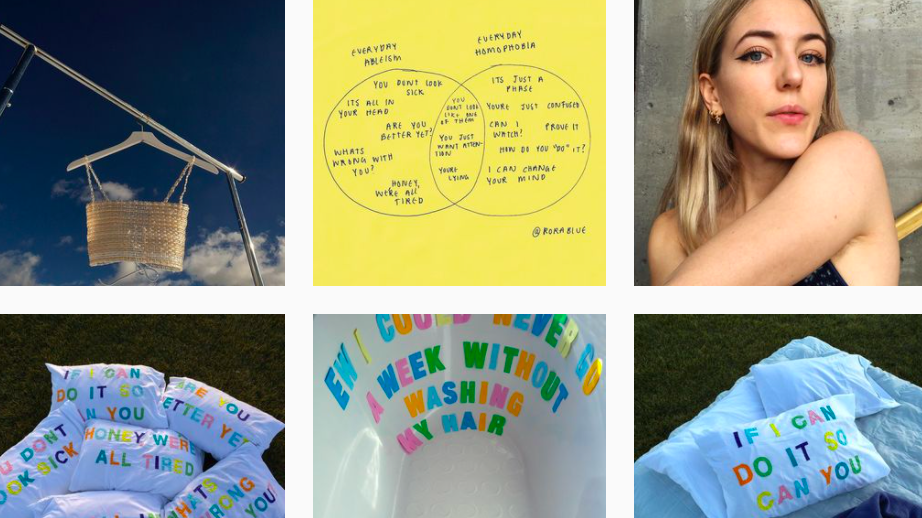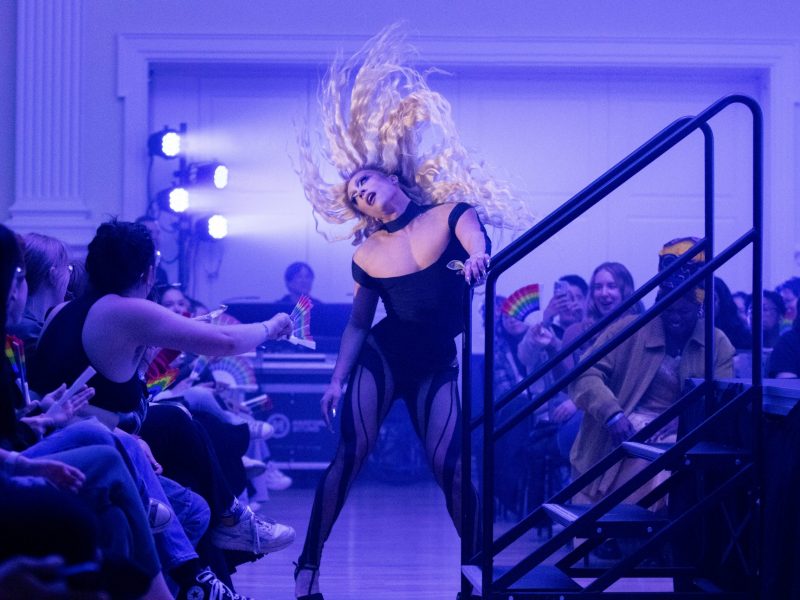Maybe quarantining and being homebound is a first for many amid the COVID-19 pandemic, but for Rora Blue, this is just a small glimpse into her everyday life.
In her new contemporary art series, “Sweet Dreams,” the 24-year-old disabled artist brings awareness to everyday ableist microaggressions. Her photography pieces delicately blend everyday objects associated with illness with colorful sticker-like words. I’ve followed the California-based artist for a couple years now, and I’m continually amazed by her work’s aesthetics paired with the weight of her societal commentary.
One of my favorite pieces of the series shows a picnic blanket with a pillow that reads “Honey, we’re all tired” in capital letters, surrounded by a colorful pill case and scattered pills. In another photo, “Maybe you aren’t trying hard enough” rests against concrete stairs, which can be associated with causing pain to people with mobility issues. Color dances through each photograph with pops of yellow, orange and pink.
She errs on the side of simplicity, emphasizing these environments where people with disabilities commonly find themselves. Pillows and blankets are pulled throughout the series. In another photo, a wheelchair sits in a field alone, reading “I could never live like that.” The scenes are often set outdoors on green grass, contributing to this idea of wanting to be somewhere else as if in a dream and using empty space to draw spectators into the messages as if the objects themselves are saying them.
[How in the world did Megan Thee Stallion get a boring magazine cover?]
“Ableism is so deeply ingrained into our culture that ableist remarks are made casually and without thought because it’s ‘just what people say,’” Blue wrote in an email interview. “Whenever someone makes an ableist comment to me, I spend the rest of the day thinking about it and that person probably never gives it a second thought. That’s harmful.”
Blue said that when COVID-19 hit nearly a year ago, she was in a period of “very low mobility” as she suffered from a combination of chronic illnesses including late-stage neurological Lyme disease and postural orthostatic tachycardia syndrome. She found that other people’s lives started to look more like hers due to pandemic-induced isolation and with that came increased accessibility.
“Virtual access to gallery spaces, events, and school have been made a priority but only because the larger public has also needed access to these things,” she wrote. “I have greatly benefitted from having access to many of these things for the first time, but it is frustrating that they were never made a priority until able bodied people needed access too.”
As someone who has lived with chronic pain and mental illness, Blue’s series comes as a sigh of relief. While my experience hasn’t been as life-altering as Blue’s, I still resonate with the ableist statements she somehow makes beautiful. She showcases them as wrong to people who have never thought twice about them.
Her pieces are a catharsis from the anger that can rise from feeling misunderstood when you have an invisible illness. Mocking passive aggressive statements like “Are you better yet?” or “Have you tried doing yoga?” feels freeing.
[New to photography? Try these photo shoots at home.]
She not only brings awareness to invisible experiences, but brings those people with common experiences together. If you read the comments on any of her recent Instagram posts, you can hear from dozens of people whose experiences have been belittled as well.
Blue does something magical when she uses other people’s submissions to fuel her art. It moves away from an individual experience and into a collective one.
“I was really floored by how many people contributed to the conversation by sharing comments with me,” she wrote.
You might recognize Blue’s “Unsent Project,” a collection of customizable digital text message graphics that aims to associate the feeling of first love with colors. The project relies on the public to participate, and it has received over 900,000 submissions.
“I didn’t know that I was an artist when I started the ‘Unsent Project’ in 2015. I was just genuinely trying to connect with other people in online spaces and create something that could serve as an emotional outlet for them,” Blue wrote.
Blue is also known for her artistic statements on sexism and gender. Her 2016 project “Handle with Care” displays photographs of everyday sexist comments transposed onto underwear, balloons, skirts, soup and body parts using the color red. Women are faceless; their eyes never visible. This project actually served as inspiration for “Sweet Dreams,” Blue wrote.
This isn’t the first time she’s done a project on chronic illness either. In 2017, she did another photo-object oriented piece titled “Chronic Illness Reimagined As Something Glamorous.” She wears pills as earrings in one photo and she’s hooked up to an IV drip full of blue glitter in another. Her beautiful use of color and creative placement of various objects combines realism with synesthesia — a perceptual phenomenon that sometimes causes people to associate letters and numbers with different senses.
“I became aware of synesthesia a couple of years ago,” she wrote. “I’ve always been extremely color focused and associated people, months and emotions with colors.”
What do we have to look forward to from Blue? Currently, she’s working on a body of work similar to “Sweet Dreams” and “Handle with Care” that looks at everyday homophobic comments that have been said to her and others.



